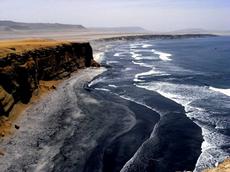Fragile ocean current
The cold water tongue that emerges in the eastern equatorial Pacific has a decisive effect on regional and global climate. A new study shows that the cooling and expansion of the subpolar oceans around 1.8 million years ago led to development of the modern cold tongue in the tropical Pacific.

The boundary area between cold deep water and warm surface water, known as the thermocline, levels off in the eastern Pacific, where it lies close to the water surface. Thus a temperature gradient exists between the eastern and western Pacific. Ocean currents are also affected by trade winds, which are responsible among other things for the fact that cold, nutrient-rich water flows at the surface off the west coast of South America. The upwelled cold deep water spreads out in a westerly direction in the tropical ocean as a large tongue of cold water. These circumstances have a decisive affect on the climate– and not just in the lower latitudes. This has not always been the case. A team of researchers led by Alfredo Martinez-Garcia has now studied how the present-day conditions emerged, and particularly how the “weather-determining” levelling out of the thermocline was formed. Martinez-Garcia, a post-doc in the Climate Geology group of Gerald Haug, professor at the Department of Earth Sciences at ETH Zurich, has now successfully reconstructed the process with the aid of geochemical analyses of core samples from the sub-polar regions.
Cooling triggers present-day climate
The scientists confirm a long-held suspicion: the subpolar regions expanded at the expense of the subtropical regions around two million years ago. The temperature gradient in the surface water temperature from east to west at that point ultimately led to the formation of the cold water tongue in its present-day extent in the interval from 1.8 to 1.2 million years ago.
Until now, evidence of this kind has remained elusive, especially due to the lack of a complete reconstruction of the surface water temperatures in the polar regions for this period of time, and thus a lack of important information about the temperature development. Martínez-Garcia, the first author of the paper, has now been able to provide this evidence by successfully reconstructing the temperatures for that period for the first time, based on two sediment cores from the “Ocean Drilling Program” from the southern and northern polar oceans. This was possible with the aid of bio-markers known as alkenones. Alkenones are lipids produced by algae and preserved in the sediment. “These lipids produced by marine phytoplankton have different numbers of double bonds, depending on the temperature of the surface waters” says Martínez-Garcia. Therefore the young scientist calibrated his data comparing it with the products of cultures of algae which were cultivated in other laboratories under various temperature conditions.
No cold water tongue causes El Niño
The reconstructed temperature curve shows that the temperature in the subpolar regions dropped by an average of 4 to 5 degrees in the period between 1.8 and 1.2 million years ago. According to the researchers, the cooling transition is linked to a change in the response of subantarctic climate to the cyclical orbital variations which affect the intensity of the solar radiation reaching the earth: the eccentricity (the Earth’s elliptical orbit round the sun), the obliquity of the ecliptic (the angle between the Earth’s axis and its orbit) and the precession (equinoxes).
The cooling down and the spread of the sea ice caused the thermocline to rise in the equatorial region of the eastern Pacific, allowing the east-to-west temperature gradient to form and the cold water tongue to spread out. Nowadays this cold water tongue warms up every 4 to 5 years: the resulting effect is called El Niño. In the eastern Pacific the nutrient-rich supply of deep water is reduced, the fish fail to appear and precipitation is unusually heavy along the western coastlines of the two American continents. In the western Pacific, on the other hand, there are periods of drought.








READER COMMENTS